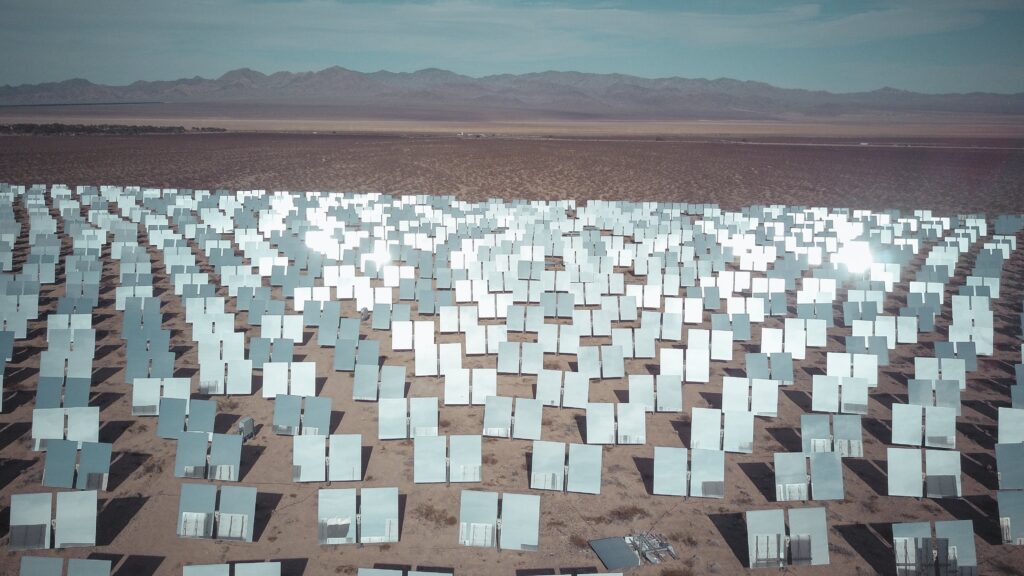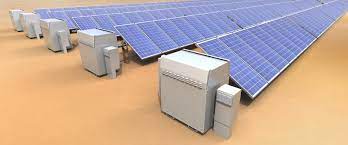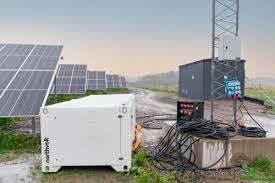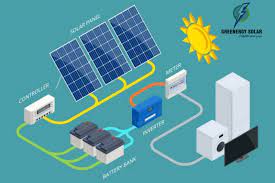Solar technology has emerged as a game-changer in the global pursuit of renewable energy. Its continual advancements not only revolutionize our energy sources but also pave the way for a sustainable and Eco-friendly future. From photovoltaic cells to concentrated solar power systems, the diverse applications and ongoing innovations in solar technology hold immense promise for addressing energy challenges while reducing our carbon footprint. As research and development accelerate, the integration of solar power into various facets of our lives is poised to reshape how we harness and utilize energy on a large scale.

Powering the Future: The Evolution of Solar Technology
In the contemporary world, the significance of renewable energy sources has become increasingly apparent. Among these, solar technology stands out as a front runner, offering a beacon of hope in the quest for sustainable energy solutions. The evolution of solar technology has been marked by transformative advancements that have not only improved efficiency but also widened its applications across various sectors.
A Glimpse into the Past

The journey of solar technology dates back to the mid-19th century when the photovoltaic effect was first discovered by Edmond Becquerel in 1839. However, it wasn’t until the latter half of the 20th century that solar technology began to gain traction. The development of the first practical solar cell by Bell Laboratories in 1954 marked a pivotal moment, leading to the inception of photovoltaic technology that converts sunlight into electricity.
Advancements in Photovoltaics
Over the decades, research and innovation in photovoltaic technology have significantly increased solar cell efficiency and reduced production costs. The transition from bulky and expensive silicon-based solar cells to thin-film solar cells and the emergence of perovskite solar cells represent key milestones. These advancements have not only made solar panels more affordable but have also expanded their potential applications, making integration into various surfaces and devices more feasible.
Beyond Photovoltaics: Concentrated Solar Power (CSP)
Apart from photovoltaics, concentrated solar power (CSP) technology has gained momentum. CSP systems utilize mirrors or lenses to concentrate sunlight onto a small area, generating high temperatures that produce steam to drive turbines and generate electricity. This approach allows for energy storage, addressing one of the limitations of photovoltaics by providing electricity even when the sun isn’t shining.
The Growing Impact

The impact of solar technology extends beyond environmental benefits. The widespread adoption of solar power contributes to energy independence, mitigates greenhouse gas emissions, and creates employment opportunities in the renewable energy sector. Countries around the globe are increasingly investing in solar infrastructure, recognizing its potential to diversify energy sources and foster a more resilient energy grid.
Challenges and Future Prospects
Despite its remarkable progress, solar technology faces challenges such as intermittency (dependence on sunlight), energy storage limitations, and the need for further cost reductions. Researchers and industry experts are actively addressing these hurdles through innovations in energy storage solutions, exploring new materials, and enhancing solar cell efficiency.
Looking ahead, the future of solar technology appears promising. Breakthroughs in materials science, coupled with ongoing research and development, hold the potential to further revolutionize the solar industry. Integrated solar solutions in urban environments, advancements in energy storage technologies like batteries, and the development of more efficient solar panels are just a few areas where progress is anticipated.
The evolution of solar technology represents a beacon of hope in the global pursuit of sustainable energy. Its transformative journey from a niche technology to a mainstream energy source underscores the potential to power a cleaner, greener future for generations to come.
This article offers an overview of the evolution of solar technology, its advancements, impact, challenges, and future prospects, aiming to highlight its pivotal role in shaping the energy landscape and fostering sustainability.
Types of Solar Power Technology

- Photovoltaic (PV) Solar Cells:
Photovoltaic technology directly converts sunlight into electricity. PV cells are made of semiconductor materials, like silicon, that absorb photons from sunlight, creating an electric current through the photovoltaic effect. These cells are commonly found in solar panels installed on rooftops, in solar farms, and even integrated into portable devices.
- Thin-Film Solar Cells:
Thin-film solar cells use thinner layers of semiconductor materials compared to traditional silicon-based cells. These cells are lighter, flexible, and can be integrated into various surfaces, making them suitable for applications like building-integrated photovoltaics, solar shingles, and portable solar devices.
- Concentrated Solar Power (CSP):
CSP systems use mirrors or lenses to concentrate sunlight onto a small area, such as a tower or receiver. The concentrated sunlight generates high temperatures that produce steam to power turbines, generating electricity. CSP technology allows for energy storage, enabling the production of electricity even when the sun is not shining.
- Solar Thermal Systems:

Solar thermal technology utilizes sunlight to generate heat rather than electricity. These systems typically consist of solar collectors that absorb sunlight to heat a fluid (such as water or oil), which is then used for space heating, water heating, or to produce steam for electricity generation.
- BIPV (Building-Integrated Photovoltaics):
BIPV integrates solar panels or solar cells directly into building materials, such as roofs, windows, or facades. This technology merges solar energy production with the building’s structure, offering a dual purpose of generating electricity while serving as architectural elements.
- Perovskite Solar Cells:
Perovskite solar cells are a relatively newer type of solar technology that uses perovskite-structured materials. They have shown potential for high efficiency and low-cost production, although they are still in the research and development phase.
TYPES OF SOLAR PANNEL

- Monocrystalline Solar Panels:
Monocrystalline panels are made from single-crystal silicon, giving them a uniform and dark appearance. They are known for their high efficiency rates and space efficiency, meaning they produce more electricity per square foot compared to other types. Monocrystalline panels tend to be more expensive due to their manufacturing process but are efficient, making them popular for residential and commercial installations.
- Polycrystalline Solar Panels:
Polycrystalline solar panels are crafted using multiple silicon crystals.
They have a speckled blue appearance and are generally less expensive to produce than monocrystalline panels. While slightly less efficient than monocrystalline panels, they offer a cost-effective option for those seeking solar energy on a budget.
- Thin-Film Solar Panels:
Thin-film solar panels use different materials like amorphous silicon (a-Si), cadmium telluride (CdTe), or copper indium gallium selenide (CIGS) deposited in thin layers onto a substrate, such as glass, plastic, or metal. They are lightweight, flexible, and easier to produce in large quantities. Thin-film panels are less efficient than crystalline silicon panels but can be advantageous for certain applications like building-integrated photovoltaics or portable solar devices due to their flexibility and lower manufacturing costs.
- Bifacial Solar Panels:
Bifacial panels have the ability to generate electricity from both their front and rear sides, capturing sunlight reflected off surfaces like the ground or nearby structures. These panels can potentially increase energy output by utilizing reflected light, although their efficiency depends on the surface they are installed on and the amount of reflected light available.
- PERC (Passivated Emitter Rear Cell) Solar Panels:
PERC panels have an added layer on the rear side of the solar cell, enhancing their efficiency by reducing electron recombination and improving light absorption. These panels are known for their higher efficiency rates compared to standard solar panels.
- HIT (Heterojunction with Intrinsic Thin-layer) Solar Panels:
HIT panels combine amorphous and crystalline silicon to improve efficiency and performance. They are known for better temperature resistance and higher efficiency in low light conditions compared to traditional panels.
Each type of solar panel has its advantages and is suitable for different applications depending on factors such as space availability, budget, efficiency requirements, and specific installation considerations. Understanding the differences between these solar panel types can help individuals and businesses make informed decisions when choosing the most suitable option for their solar energy needs.
How can I store excess solar energy

There are several methods available to store excess solar energy generated from solar panels for later use when the sun isn’t shining. Here are a few common ways to store this surplus energy:
- Battery Storage Systems:
Installing batteries, such as lithium-ion or lead-acid batteries, allows you to store excess electricity produced by your solar panels. These batteries store the energy and can release it when needed, providing a consistent power supply even during times of low sunlight or at night.
- Solar Thermal Energy Storage:
For solar thermal systems that generate heat rather than electricity, thermal energy storage is used. This method involves storing the heat generated during sunny periods in insulated containers or materials (like molten salts or rocks) and using it later for heating or electricity generation.
- Hydrogen Production through Electrolysis:
Excess electricity generated by solar panels can be used for electrolysis, a process that splits water into hydrogen and oxygen. The produced hydrogen can be stored and used later as a fuel source for various applications, such as fuel cells for electricity generation or as a clean-burning fuel for transportation.
- Pumped Hydro Storage:
In some cases, excess energy can be used to pump water to a higher elevation in a reservoir during sunny periods. Later, when electricity is needed, the water is released downhill, passing through turbines to generate electricity as it flows.
- Flywheel Energy Storage:
This technology uses the excess energy to spin a rotor at high speeds, storing the kinetic energy. When electricity is required, the spinning rotor is slowed down, converting the kinetic energy back into electricity.
Choosing the right storage method depends on various factors, including the available space, the amount of energy needed, cost considerations, and the specific requirements of your location and energy usage pattern.
Battery storage systems, in particular, have become popular due to their efficiency, scalability, and decreasing costs over recent years. They allow homeowners, businesses, and even utility-scale solar projects to store excess energy during peak production times and use it later, effectively maximizing the utilization of solar energy and providing a more reliable power supply.
Each of these solar power technologies has its unique advantages and applications, contributing to the diversification and expansion of solar energy usage across various sectors.
What technology can be used to control the load connected to solar cells?

Solar power, heralded as a sustainable and renewable energy source, has experienced rapid adoption due to its Eco-friendly nature and the promise of reduced dependence on traditional fossil fuels. However, harnessing solar energy efficiently involves not only capturing sunlight but also managing the loads connected to solar cells. Various technologies play crucial roles in optimizing and adjusting these loads to ensure maximum efficiency and stability within solar power systems.
One primary technology used for load adjustment in solar cells is the Maximum Power Point Tracking (MPPT). This technology is integral in maximizing the efficiency of solar panels by continuously adjusting the electrical operating point of the modules. Solar panels have a specific point, the Maximum Power Point (MPP), at which they can deliver the highest possible power output. MPPT algorithms and controllers track this point by varying the electrical operating parameters, such as voltage or current, to match the panels’ ideal conditions with the varying sunlight intensity. This optimization ensures that the solar cells operate at their peak efficiency, extracting the most energy available under different environmental conditions.
Micro inverters and Power Optimizer are also instrumental in load adjustment within solar power systems. Traditionally, solar panels are connected in series, which can result in performance loss due to shading or differences in panel conditions. Micro inverters and power optimizer mitigate these issues by enabling the management of individual solar panels separately. Micro inverters convert the DC power generated by each solar panel into AC power right at the panel itself, allowing for independent operation and optimized performance. Power optimizer, on the other hand, work in conjunction with a central inverter to adjust the DC voltage from each panel, enhancing overall system efficiency by mitigating losses caused by panel mismatch or shading.
Furthermore, Battery Energy Storage Systems (BESS) are gaining prominence as a means of load adjustment in solar power setups. These systems store surplus energy generated by solar panels during periods of high production and make it available during times of low sunlight or high demand. Advanced battery management technologies ensure the efficient charging and discharging of these batteries, enabling a more consistent and reliable power supply. By integrating BESS, solar power systems can enhance their flexibility, improve grid stability, and even enable off-grid applications.
In addition to these, Smart Grid Technologies play a crucial role in load adjustment by enabling better communication, control, and coordination between various components in a solar power system. Smart grids facilitate real-time monitoring of energy consumption, allowing for dynamic adjustments based on demand fluctuations. Through smart meters and sophisticated monitoring systems, energy providers can manage loads effectively, optimizing the utilization of solar power and reducing wastage.
As solar energy continues to evolve and witness widespread adoption, the integration of these technologies for load adjustment becomes increasingly vital. With ongoing advancements and research, these technologies are becoming more efficient, cost-effective, and scalable, further contributing to the growth and sustainability of solar power systems worldwide.
In conclusion, a combination of various technologies such as MPPT, micro inverters, power optimizer, battery energy storage systems, and smart grid technologies collectively contribute to adjusting loads connected to solar cells. This integration not only maximizes energy harvesting from solar panels but also ensures a more stable, reliable, and efficient solar power generation and distribution system for a sustainable energy future.
What are some examples of how passive solar technology is applied?

Passive solar technology represents a sustainable approach to utilizing the sun’s energy without the use of mechanical or electrical devices. It leverages architectural design, building materials, and natural processes to efficiently capture, store, and distribute solar energy for heating, cooling, and lighting within structures. This technology offers a range of practical applications, transforming how we design and construct buildings while reducing reliance on conventional energy sources.
- Solar Heating and Day lighting:
One prominent application of passive solar technology is in heating buildings. Through thoughtful architectural design, features such as large south-facing windows, thermal mass materials, and proper insulation capture and store solar heat during the day. This stored heat is then slowly released into the building interior, reducing the need for artificial heating sources, especially during colder months. Additionally, passive solar design emphasizes natural daylighting, strategically placing windows and reflective surfaces to optimize the amount of sunlight entering a space, reducing the reliance on artificial lighting.
- Natural Cooling and Ventilation:
Passive solar techniques also aid in natural cooling and ventilation of buildings. Features like shading elements such as overhangs or trellises prevent excessive solar heat gain during warmer seasons. Proper orientation and design allow for cross-ventilation, enabling the movement of air through a building, promoting natural cooling. Techniques like night purging, where cooler nighttime air is used to flush out heat accumulated during the day, further enhance the passive cooling process.

- Trombe Walls and Thermal Mass:
Trombe walls, a passive solar design element, consist of a high-mass wall with a glass exterior. These walls absorb and store solar heat during the day, releasing it slowly into the interior space over time, contributing to space heating. Similarly, the use of thermal mass materials, such as concrete, brick, or tile, within a building helps store and distribute solar heat, regulating indoor temperatures by stabilizing fluctuations caused by external weather conditions.
- Greenhouses and Solarium:
Passive solar technology finds application in greenhouses and solarium. These structures use the greenhouse effect to trap solar radiation, creating a warm environment suitable for plant growth. By utilizing transparent materials, such as glass or poly carbonate panels, in combination with proper ventilation, these spaces can efficiently harness solar energy to create ideal growing conditions for plants, extending growing seasons or allowing year-round cultivation.
- Passive Solar Water Heating:
Another application involves passive solar water heating systems. These systems utilize solar collectors and storage tanks to capture and store solar thermal energy for heating water used in homes or other facilities. Through natural circulation or convection, heated water moves from the collectors to the storage tanks, providing a cost-effective and environmentally friendly alternative to conventional water heating methods.
Passive solar technology, with its diverse applications, not only reduces energy consumption and operational costs but also minimizes the environmental impact of buildings. Its integration into architectural design and construction practices fosters energy-efficient, sustainable, and comfortable living and working environments. As society continues to prioritize sustainability and renewable energy, passive solar technology stands as a beacon of innovation, offering practical solutions to reduce our carbon footprint and embrace a more harmonious relationship with our environment.

To get information about other Digital Gadgets visit.
Solar Energy FAQs:
Understanding the various types of solar power technology and addressing common questions can assist individuals and businesses in making informed decisions about adopting solar energy solutions.
How does solar energy work?
Solar energy is generated when sunlight is converted into electricity through photovoltaic cells or used to produce heat in solar thermal systems. Photons from sunlight hit the solar panels, freeing electrons in the semiconductor material, generating a flow of electricity.
Are there different types of solar panels?
Certainly! There are different kinds available, such as monocrystalline, poly crystalline, and thin-film solar panels. Each type has its characteristics, efficiency levels, and suitability for different applications.
What are the benefits of solar energy?
Solar energy is renewable, abundant, and emits no greenhouse gases during electricity generation. It reduces electricity bills, promotes energy independence, and creates jobs in the renewable energy sector.
What factors affect solar panel efficiency?
Efficiency can be influenced by sunlight intensity, panel orientation, temperature, shading, and the quality of the solar cells used in the panel.
Is solar energy suitable for all locations?
While solar energy can be harnessed in most regions, the amount of sunlight available varies based on factors such as geographic location, weather patterns, and obstructions like trees or buildings.
What is the lifespan of solar panels?
Most solar panels have a lifespan of 25 to 30 years, but their efficiency might decrease slightly over time. Proper maintenance and regular cleaning can help extend their life and optimize performance.
How can I store excess solar energy?
Excess energy generated during peak sunlight hours can be stored in batteries.
How do solar panels work?
Solar panels work by utilizing photovoltaic cells to convert sunlight into electricity. When sunlight hits the panels, the photovoltaic cells generate direct current (DC) electricity, which is then converted into alternating current (AC) electricity by an inverter for use in homes or businesses.
Are there any limitations to solar power?
Solar power generation depends on sunlight, so it is intermittent and varies based on weather conditions and time of day. Energy storage solutions are required to provide electricity when the sun isn’t shining.
How do on-grid and off-grid solar systems differ from each other?
On-grid solar systems are connected to the main electricity grid, allowing excess energy to be exported, and drawing power from the grid when solar production is insufficient. Off-grid systems operate independently, utilizing batteries for energy storage and are not connected to the grid.
Are solar panels suitable for all locations?
While solar panels can be installed in most locations, their efficiency depends on factors like sunlight exposure, shading, roof orientation, and local climate conditions. Some regions may be more conducive to solar power generation than others.
Understanding the various types of solar power technology and addressing common questions can assist individuals and businesses in making informed decisions about adopting solar energy solutions.


Its like you read my mind! You seem to know so much about this, like you wrote the book in it or something. I think that you can do with a few pics to drive the message home a bit, but other than that, this is wonderful blog. A fantastic read. I will certainly be back.
смотреть сериалы онлайн бесплатно без регистрации